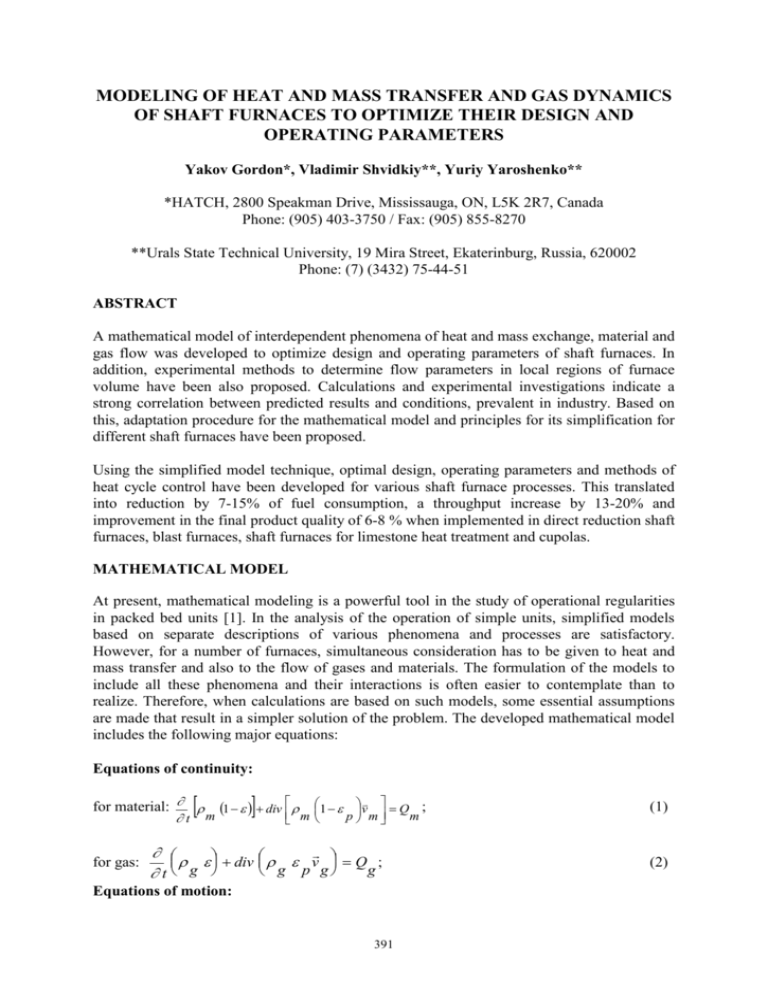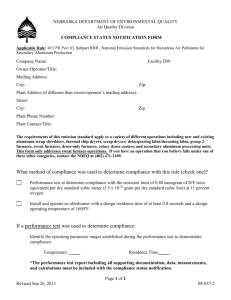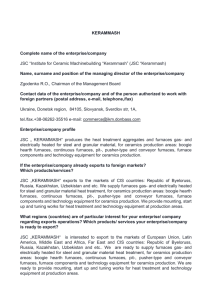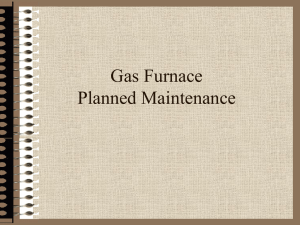MODELLING OF PHYSICO-CHEMICAL PHENOMENA IN THE
advertisement

MODELING OF HEAT AND MASS TRANSFER AND GAS DYNAMICS OF SHAFT FURNACES TO OPTIMIZE THEIR DESIGN AND OPERATING PARAMETERS Yakov Gordon*, Vladimir Shvidkiy**, Yuriy Yaroshenko** *HATCH, 2800 Speakman Drive, Mississauga, ON, L5K 2R7, Canada Phone: (905) 403-3750 / Fax: (905) 855-8270 **Urals State Technical University, 19 Mira Street, Ekaterinburg, Russia, 620002 Phone: (7) (3432) 75-44-51 ABSTRACT A mathematical model of interdependent phenomena of heat and mass exchange, material and gas flow was developed to optimize design and operating parameters of shaft furnaces. In addition, experimental methods to determine flow parameters in local regions of furnace volume have been also proposed. Calculations and experimental investigations indicate a strong correlation between predicted results and conditions, prevalent in industry. Based on this, adaptation procedure for the mathematical model and principles for its simplification for different shaft furnaces have been proposed. Using the simplified model technique, optimal design, operating parameters and methods of heat cycle control have been developed for various shaft furnace processes. This translated into reduction by 7-15% of fuel consumption, a throughput increase by 13-20% and improvement in the final product quality of 6-8 % when implemented in direct reduction shaft furnaces, blast furnaces, shaft furnaces for limestone heat treatment and cupolas. MATHEMATICAL MODEL At present, mathematical modeling is a powerful tool in the study of operational regularities in packed bed units [1]. In the analysis of the operation of simple units, simplified models based on separate descriptions of various phenomena and processes are satisfactory. However, for a number of furnaces, simultaneous consideration has to be given to heat and mass transfer and also to the flow of gases and materials. The formulation of the models to include all these phenomena and their interactions is often easier to contemplate than to realize. Therefore, when calculations are based on such models, some essential assumptions are made that result in a simpler solution of the problem. The developed mathematical model includes the following major equations: Equations of continuity: for material: 1 div 1 v Q ; m p m m t m for gas: div v Q ; g g p g t g Equations of motion: 391 (1) (2) d 1 p for material: m 1 - v m m 1 - g div 1 p R ; d t 1 v d p g for gas: g - grad P R ; g dt g (3) (4) Equations of heat exchange: for material: 1 cm m dT m T T q ; v g m m dt (5) dT g T T q ; for gas: c g g dt v g m g (6) Equations of mass exchange: 1 1 / 3 d 3 T T - for carbonates, i d t H R 2 1 1 1 / 3 o m L k (7) dC x k A C k C and x s x y dt (8) d d t C* v o g gradC - for iron ore pellets and lump ore. x (1 ) m m (9) Equations of melting: 1 Tm 1 2 Tm r ; 0 r t ; T ,t T ; 1 m 1 melt 2 r a t r r 1 T m 0; t 0 : 0 R ; T r,0 T r . r 0 : 1 k m m r T ,t m 1 L r t , T T 1 f g melt m mt r 1 and also the equations of state, where: (10) (11) (12) - density; and - porosity and permeability of the bed; v - velocity; Q - source and p discharge of mass; q - heat source; t - time; R - force of bed resistance to gas flow movement; P - pressure; , C and a - heat conductivity, heat capacity and thermal diffusivity, respectively; T - temperature; - stress tensor; g - gravitation acceleration; heat exchange coefficient; C - reductant gas concentration in gas flow; k - total mass x exchange coefficient; k - equilibrium ratio of reductant gas and products of reaction; C xy 392 concentration of the products of reaction in gas flow; - reduction ratio (oxygen based); A - material surface; V - gas flow under a standard conditions; G - initial material amount; O m - initial oxygen amount in iron ore or pellets; H and L - specific heat of carbonates 2 L dissociation and melting; - ratio of carbonates dissociation; T - material lump surface o temperature; T - temperature of dissociation; - initial time of material melting; i 1 r residue radius of particle; - particle radius; indices: g , m and melt - gas, material and melting; F and v - surface and volumetric. One of the characteristic features of the system of equations (1) - (12) is the application of conservation equations (1) and (2). The right part of these equations is equal to gas and material source of mass. This is bound up with a fact that a lot of material heat treating processes are followed by mass exchange between the charge and gas. Despite the mass exchange between gas and material it is almost always possible to derive value V * related g to the real gas volume by the relationship V * a V without changing of its meaning. If g g g the mass exchange does not occur and gas mass G remains constant can be taken as g g a coefficient g (13) V * G V o 273 P V (P o T ) , g g g g g g g g g where indices o - points the standard conditions. In the most complex mass exchange between material and gas in the blast furnaces, the volume of inert gas nitrogen ( V N 2 ) is taken as a constant value g (14) V * V N 2 N 273P V / ( P o T ) a V g g 2 g g g g g g Since value V * has no sources and discharges the right part of conservation equations is g equal to zero. In this case a considerable effect may be obtained for steady state problems: stream function can be used for velocity calculation [2,3]. For example, the equation (2) in the case of steady state two-dimensional problem may be written as follows: ( a v ) ( a v ) 0 , (15) x p g x y p g y If the gas flow in the layer of material is assumed to be vortex-less [3,4] the stream function field is defined by solving the problem: 1 1 0. x a x y a y (16) p g p g The effectiveness of the stream function used to find the gas velocities is known to be connected not only with the simple form of equation (19), but also with the simplicity of defining boundary conditions for . If we enter a pair of orthogonal vectors ( n and ) into 393 each point of gas flow boundary so that vector n is directed into the unit and vector scans the boundary clockwise then: 1 1 v and v . (17) a n n a a p g p g Hence for the two points lying on the boundary we obtain 2 (18) a v V * , 2 1 p g n 1 1 2 1 where V * is V * value introduced into the unit between bound points 1 and 2. 12 g This widely known procedure of specifying boundary conditions for defining stream function field can be applied only to the units with unconfined boundaries of the furnace. There are, however, a number of furnaces with gas vents or other devices located inside the furnace. In this case, closing the boundary line conventional break of the gas flow area from the outer boundary to the devices inside the unit should be used. The conventional break is infinitesimal thickness and can be made along any line, e.g. a horizontal one (Fig. 1). Each real point, falling on this line is divided into a pair of points ( 0 - 0’, 1 - 1’, 2 - 2’ etc. ). The conventional break does not disrupt the continuity of the gas velocity and pressure fields as well as other physical quantities. It affects only the stream function field. Since the field velocity continuity is not disrupted the values of gas velocity components perpendicular to the boundary from different sides of the break ( v and v ' ) at any point are equal in absolute n n magnitude but are opposite in sign (Fig. 1). Then from equation (18) it follows: o N o' (19) N' or o o' N N' const . (20) Value may be determined by integration along the boundary of the device located in the working space from point 2 to point 2’ using equations (19) - (20). Thus value in N point can be found from the stream function value obtained earlier in any N ' point lying on the conventional break and vice verse. When the conventional break is intersected a sudden discontinuity of stream function takes place. The boundary condition on the line of conventional break is equation (20), which numerical solution takes into account of the stream function discontinuity. Assume that the line of conventional break passes in the given area and then stream function field ' is selected. If the points showing difference i are on one side of the conventional break, this difference will not change since neither the velocity field and hence not the integration result for equation (19) have changed. If the intergrable line intersects the break line and 3 ' 3' ' ' then: 2 2 1 3 2 1 p a g v n d p a g v n d 3 1 ' 2 ' 3' '. (21) The shaft furnace general design is presented in Fig. 2. The technological gases enter the furnace through tuyeres or other gas distribution devices. These gases can be evacuated from the furnaces partially or completely through the gas evacuation vents. The vertical profile of such shaft furnace can be determined by certain numbers of straight intercepts. Vertical coordinates “z” edges of these intercepts are variable excluding the furnace bottom and stockline. Also the radius “r” is assigned for all the elements of the furnace profile. 394 Fig. 1. Calculation of the stream-function field, when the boundaries are broken Fig. 2. General design and conform transformation of the shaft furnace profile. Introduction of new coordinates y z and x ( r r t ) / ( rc r t ), allows the performance of the conform transformation of the furnace actual complicated profile to a simple cylinder [Fig. 2 (b)]. In this figure “r” is a radius of a singular point of finite - difference grid, “rc and rt” - are the radiuses of furnace gas distribution device. “rt” = 0 if there is no gas distribution device. In transformed system of coordinates “y” changes in the range of 0-Zb and “x” - in the range of 0-1. Transformation of the area of material and gas movement naturally requires the transformation of the equations of the mathematical model. Complete numerical solutions of the equation system (1) - (12) on the existing computers is extremely laborious. It requires a large on-line memory, is time-consuming and fails to provide high accuracy. All this raises a problem of developing certain concept to be used in simplifying the mathematical model. THE CONCEPT OF SIMPLIFYING THE MATHEMATICAL MODEL The first problem facing the researcher in mathematical modeling bed gas mechanics is the dimensional representation of the task. The number of the tuyeres varied from 8 to 32, which is characteristic of the present blast furnaces, cupolas, etc. The calculations have shown that when the distance between the tuyeres in cylindrical and rectangular shaft furnaces are 0.6 m and 0.52 m respectively, the upper boundary of three-dimensional motion [2,4] practically coincides with the tuyere level. Hence, one can conclude that two-dimensional mathematical models may be used. The second problem to be addressed is whether the hypothesis on the potentiality of gas flow in shaft furnaces is admissible. Calculations shown that with Re=1000 the error of potential approximation in finding of the local value of the gas velocity on the two- dimensional zone boundary does not exceed ±5 per cent or 0.05 m/s. From the viewpoint of gas flow division 395 and velocity field rearrangement, the maximum error is not more than 10 per cent. As for the average final temperature and chemical composition of the material with the application of the potential model, they will be correct since the local errors have different signs and practically equalize each other [2,5]. By solving the non-isothermal problem of shaft furnace gas mechanics, it has been found that the nature of the gas temperature field and melting front configuration mainly depend on gas distribution. Non-isothermal gas movement results in the increase of the zone of non-uniform gas distribution. The effect of non-isothermal motion reveals itself in the high temperature region (more than 600°C) [1,2,6]. Based on the regularities of attenuating radioisotope emission in narrow beam geometry, a procedure for determining local porosity of the bed in circular shaft furnaces has been developed. In order to do this, the cross-section of the shaft is divided into a number of circles; the absorption intensity is measured by parallel chords tangential to the circles and the local value of porosity found by the following formula: n 1 ln K n 2 k ch i di i 1 n 1 , (22) m dn where: K n - coefficient of attenuating radioisotope emission along the chord n; - mass coefficient of attenuating of radiation, m2/kg; m - material balk density, kg/m3; k=0 with n=1, k=1 with n1, and d m and di are portions of the nth chord in the n th and ith circles respectively. Experimental investigations of porosity during tapping have shown that in the main technological zones, i.e. calcination, metallization or preheating etc. located at distances from the tapping hole exceeding 2 furnace radiuses the charge movement, does not effect the porosity fields and their nature greatly depends upon the effect of gas flow on lump material bed (Fig. 3) [2]. THE RESULTS OF INVESTIGATION AND THEIR APPLICATION By the conducted investigation it has been established that uniformity of radial gas distribution mainly depends upon tuyeres’ protrusion, their diameter, slope and the distance from the furnace bottom (melting surface). The formation of velocity and pressure fields is mostly affected by the tuyere’s protrusion. Its optimum value from the viewpoint of gas distribution uniformity is not stable and greatly depends on its diameter. With tuyeres’ diameters and wind rate characteristic of the shaft furnace the optimum value of their protrusion is 0.3-0.36 radius of the unit. With such a protrusion the minimum non-uniformity of gas distribution will occur if the tuyere slope is between 17 and 25 degrees . Peripheral wind input has been found to be highly effective when it is combined with a knuckle of the shaft which optimum radius is 0.8 that of the unit. Using bed looseners as an element of the gas distribution device allows the unit capacity of the furnace to be greatly raised. 396 Fig. 4. Distribution of relative gas of the velocity vrel over the furnace levels. Fig. 3. Distribution of porosity in lower part shaft furnace pilot plant a) tapping velocity - 25 kg/h; b) tapping velocity - 30 kg/h; ----- tapping hole Figure 4 shows the distribution of the modules of the gas velocity in a blast furnace. It can be concluded that stack taper has a considerable influence on non-uniformity of gas distribution. Two values of zone of two dimensional gas movement are observed in the range of stack batter from 780 to 900 with the optimum tuyere protrusion. The first zone is established in between tuyeres level and belly. Deformation of the gas flow occurring with transition into the stack leads to the formation of the second zone of two-dimensional flow and this zone is growth with decrease of the stack taper. With tuyere protrusion values differing from the optimum there is only one value of the height of the zone of two-dimensional gas flow. In a cylindrical stack, however, a continuous decrease of non-uniformity of gas-distribution occurs up the bed even with optimal tuyeres protrusion. This phenomena is used for optimum design of the shaft furnaces for limestone heat treatment, DRI shaft furnaces, cupolas etc. [7,8,9]. The autonomous gas-dynamic operation of metallization or calcination zone in the cylindrical shaft furnace can be provided either by means of making a shaft knuckle in the division zone whose diameter is 0.2 - 0.4 that of the shaft or by pumping reducing gas into leadaways of the cooling zone making up 10-15% of cooling gas consumption. The gas flow from the cooling zone into the calcination or reduction zone, does not affect the optimum parameters of gas distribution devices, causing simultaneously worsening heat and reduction operation of the axial section of the furnace. 397 The equations system (1) – (12) was also used to analyze the operation of the Midrex metallizing furnace installed at Oskol metallurgical works. Through simulations, it was determined that the following modifications to the furnace and furnace operation had to be made in order to obtain optimum temperature and gas flow profiles (Fig. 5): The installation of a central gas outlet device at the top of the furnace. When adjusted optimally, this device increases the intensity of heat exchange processes and eliminates the area of lower temperature along the axis in the preheating and reduction zones, with the operation parameters of the upper gas seal remaining unchanged Determination of optimal parameters for the cooling gas outlet devices, with the final aim of eliminating gas flow exchange between the cooling and reduction zones. The introduction of tuyeres for the cooling gas feed at the bottom of the cooling zone, and optimization of flow ratios between the central and peripheral nozzles for cooling gas. The use of the tuyeres allows an increase in the working space of the cooling zone and an improvement in the heat treatment of the metallized pellets. This modification does, however, require a slightly higher pressure in the lower gas seal to maintain the reductive atmosphere inside the furnace Fig. 5. Temperature profiles and gas flow in Oskol shaft furnace. On average, the natural gas feed rate was decreased by 7-9%, the furnace capacity increased by 13-17%, and the reduction ratio increased by 6-8% as a result of the implementation of these changes. 398 The introduction of the recommendations and methods of controlling the process in cupolas and the shaft furnaces for limestone heat treatment raised the capacity of the units by 10 15%, improved the quality of the finished product by 3 - 5%, reduced fuel rate by 5 - 8% and lowered CO emissions into the atmosphere by 25 - 30%. The employment of the optimum tuyeres slope and protrusion decrease the coke rate in the blast furnaces by 2-4%. CONCLUSIONS The following conclusions can be made based on this study results: The mathematical model of interconnected processes of heat and mass transfer, gas and material movement and material melting for blast furnaces, shaft furnaces and cupolas was developed. The adequacy of the results of calculations and the experimental data is shown. A method for conversion of conservation equation is developed. It leads to a sufficient increase of the efficiency of stream function use for gas velocity calculation. The procedure of specifying boundary conditions for the shaft furnaces with internal gas distribution devices is described. Application of the developed method allows to determine the parameters of the shaft furnaces to maintain the autonomous operation of technologic al zones. The optimal design and operating parameters for the blast furnaces, shaft furnaces and cupolas have been developed. Their implementation sufficiantly improved the furnaces performance. REFERENCES 1. “Blast Furnace Phenomena and Modeling”, Committee Chairman Yasuo Omori. Elsevier Applied Science, London and New York. 1987. 2. Gordon Ya, Bokovikov B.A., Shvidkii V.S., Yaroshenko Yu. G.: “Heat Operation of Shaft Furnaces and Close-Packed Units”. Metallurgia, Moscow, 1989. 3. Gosman A.D., Pun W.M., Runchal A.E., Spalding D.B., Wolfshtein M.: “Heat and Transfer in Recirculating Flows”, Academic Press, London, 1969. 4. Viswanathan N.N., Srinivasan M.N., Lahiri A.K.: “Steady State Three-Dimensional Mathematical Model For Cupola”, Ironmaking and Steelmaking, 1997, Vol. 24, No. 6, p.p. 476-483. 5. Shvidkii V.S., Gordon Ya., Bokovikov B.A., Yaroshenko Yu.G.: “Mechanisms of Gas Movement in the Tuyere Region of Blast Furnaces”, International Blast Furnace and Raceway Symposium, Newcastle, Australia, 1981, p.p. 17.1-17.7. 399 6. Gordon Ya., Shvidkii V., Yaroshenko Yu., Vagin N., Biruchev V.: “A Multidimensional Mathematical Model for Design and Operation of the Shaft Furnaces”, Proceedings book of the 15-th CMMI Congress, Sun City, South Africa, 1994, September 4-8, Vol. 2, p.p. 93-97. 7. Gordon Ya.: “Improvement of Heat Treatment in Midrex Furnace”, Steel World, 1996, No. 1, p.p. 33-35. 8. Gordon Ya., Madison V., Shvidkii D., Yaroshenko Yu.: "Improvement of the Technology for Carbonate Materials Heat Treatment in the Shaft Furnaces", Steel (Russia), No. 6, 1996, p.p. 84 - 86. 9. Gordon Ya.: "Optimization of Thermo-chemical Packed - Bed Systems", 1996 CSME Forum, McMaster University, Hamilton, Ontario, Canada, 1996, May 7 - 9, p.p. 216 220. 400






